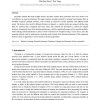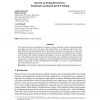IDA
2002
Springer
14 years 6 months ago
2002
Springer
Feature subset selection is important not only for the insight gained from determining relevant modeling variables but also for the improved understandability, scalability, and pos...
AAMAS
2002
Springer
14 years 6 months ago
2002
Springer
Abstract. One of the main questions concerning learning in a Multi-Agent System's environment is: "(How) can agents benefit from mutual interaction during the learning pr...
IJON
2007
14 years 6 months ago
2007
We focus on how infants’ discovery of a range of affordances and effectivities contributes to participating in a new activity. We emphasize how caregivers bracket ongoing action...
KBS
2006
14 years 6 months ago
2006
Ensemble methods that train multiple learners and then combine their predictions have been shown to be very effective in supervised learning. This paper explores ensemble methods ...
JMLR
2006
14 years 6 months ago
2006
We develop kernels for measuring the similarity between relational instances using background knowledge expressed in first-order logic. The method allows us to bridge the gap betw...
JMLR
2008
14 years 6 months ago
2008
In this paper we introduce an improved implementation of locally weighted projection regression (LWPR), a supervised learning algorithm that is capable of handling high-dimensiona...
JMLR
2008
14 years 6 months ago
2008
We show that the relevant information of a supervised learning problem is contained up to negligible error in a finite number of leading kernel PCA components if the kernel matche...
CORR
2010
Springer
14 years 6 months ago
2010
Springer
Sparse methods for supervised learning aim at finding good linear predictors from as few variables as possible, i.e., with small cardinality of their supports. This combinatorial ...
BMCBI
2010
14 years 6 months ago
2010
Background: Extracting protein-protein interactions from biomedical literature is an important task in biomedical text mining. Supervised machine learning methods have been used w...
GECCO
2008
Springer
14 years 7 months ago
2008
Springer
A possible alternative to fine topology tuning for Neural Network (NN) optimization is to use Echo State Networks (ESNs), recurrent NNs built upon a large reservoir of sparsely r...






